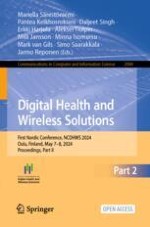
Open Access 2024 | OriginalPaper | Buchkapitel
Research for JYU: An AI-Driven, Fully Remote Mobile Application for Functional Exercise Testing
verfasst von : Neil Cronin, Ari Lehtiö, Jussi Talaskivi
Erschienen in: Digital Health and Wireless Solutions
Verlag: Springer Nature Switzerland
Aktivieren Sie unsere intelligente Suche, um passende Fachinhalte oder Patente zu finden.
Wählen Sie Textabschnitte aus um mit Künstlicher Intelligenz passenden Patente zu finden. powered by
Markieren Sie Textabschnitte, um KI-gestützt weitere passende Inhalte zu finden. powered by